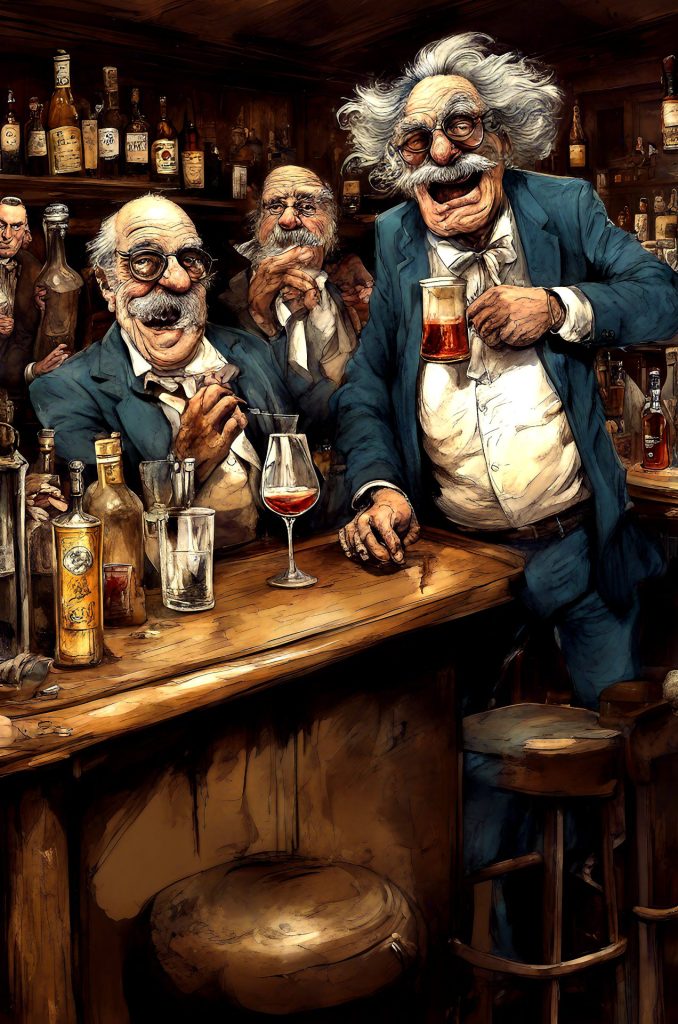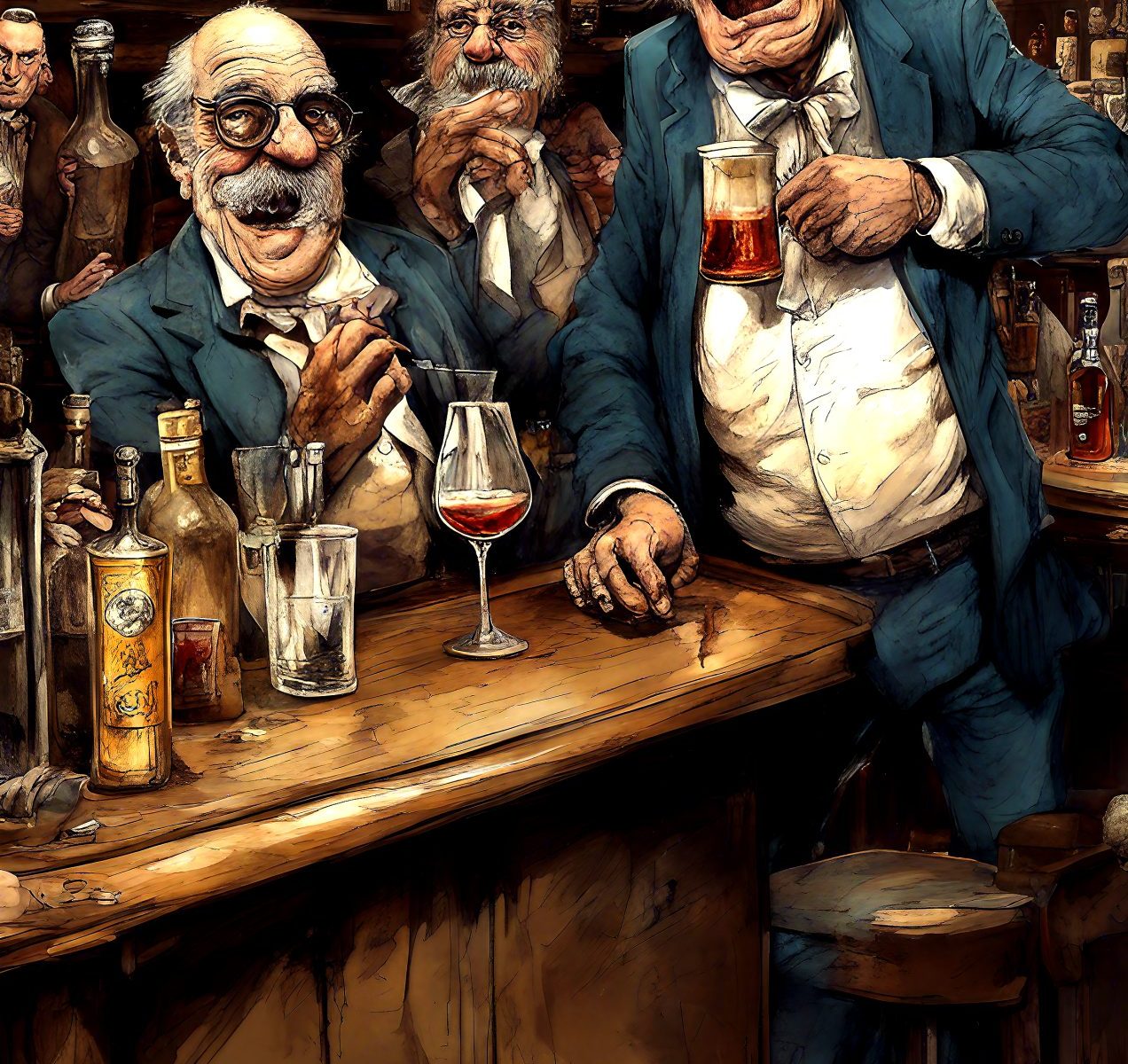
Is it possible to describe the French House pub without reverting to ‘bohemian’ like everyone else? Bugger, too late. To catalogue all the famous and the infamous who ever took wine in there would take a small volume in itself. Just assume that all the good, bad and ugly luminaries who have ever alighted in Soho in the last 100 years have dropped by for a glass or three and be done with it. Notably they are treated with the same friendly indifference by the regulars as anyone else.
The French is not the best place for drinking beer. The range is not great and it has been served only in half-pints since the 1970s when rowdy French sailors insisted on smashing heavyweight, dimpled pint glasses over each other’s heads. It serves to deter less affable newcomers. An exception is made once a year, for ‘Pints Day’, on 1st April, when pints are auctioned off for charity by celebrity clients.
Rather, the order of the day is French wine, of which there is a fine range, champagne by the glass, litre bottles of Breton cider or a pastis. At one point more Ricard was sold in the French than anywhere else in the country. An absinthe fountain stands behind the bar, with which water used to be dripped through a sugar cube, sitting on a leaf-shaped spoon, into a glass of the ‘Green Fairy’ beneath.
Above the bar sits a bijou dining room where Fergus Henderson got his start in 1992, developing his ‘Nose to Tail’ philosophy, before launching St John’s in 1994, his wife Margot and Melanie Arnold taking over until they launched The Rochelle Canteen. A few incarnations later the talented Neil Borthwick is now behind the pass to critical acclaim, giving an Anglo-French touch to fine rustic fare, with the likes of oysters mignonette, cervelle de veau, pommes aligot, ox tongue and madeleines regularly featured on the menu. Probably best not invite your vegan niece though.
First volume of The Good Food Guide, 1951
The walls are adorned with photographs and paintings, both historic and contemporary, of the French and its denizens. Over the years John Claridge has shot over 500 remarkable formal portraits of regulars from a makeshift studio in the flat upstairs, while the masterly Peter Clark has, with glass in hand, dexterously documented contemporary life in the bar
Photographer John Claridge,
Formerly ‘Schmidt’s’, Victor Berlemont bought the ‘York Minster’, as it became, at the outbreak of the First World War from a German family who suddenly found themselves persona non grata. The bill of sale can be seen on a wall in the bar. Adorned with a luxuriant handlebar moustache, with his French accent and passion for pastis,Victor, despite being Belgian, imparted a distinct Gallic air to the place. He installed a boxing ring in the cellar for his hero, French pugilist ‘le grand Georges’ Carpentier, to perform in and take on all-comers. Years later that same cellar would play host to Errol Flynn and Orson Welles for a bout of wine tasting. Victor had a light touch to ejecting disagreeable patrons:
“One of us will have to go and it’s not going to be me.”
After the fall of France in June 1940, it became the unofficial headquarters of France’s government-in-exile, the Free French Forces, led by Charles de Gaulle. He was taken with the wine, imported in hogsheads by Victor. It is claimed that he wrote ‘À tous les Français’, his rallying cry to the French people he had left behind, in a room upstairs. Viva la French.
Denton Welch, 1945
Gaston, Victor’s son and heir, took over the reins upon his return from WWII. Likewise sporting a wondrous moustache, suavely kissing ladies hands, fleur-de-lys on his lapel, swilling pastis, he was most undoubtedly his father’s son. As Frenchified as his Belgian papa, despite living in Soho his whole life, having been born in rooms above the bar in 1914, he loyally maintained the Gallic atmosphere of the French. He retired in 1989 to a huge street party on, appropriately enough, the 200th anniversary of Bastille Day, to this day an annual fixture in the pub’s calendar.
Known to all and sundry as just The French for obvious reason, the pub was officially The York Minster until 1984, when an ecclesiastical establishment of the same name, the Cathedral and Metropolitical Church of Saint Peter in York, aka York Minster, was ravaged by a devastating fire. Large donations started to arrive at the pub for the restoration fund. Realising the confusion Gaston contacted the bishop who said that he had never heard of the pub but informed him that cases of claret had been occasionally delivered to the church, addressed to the York Minister. He had assumed, so he claimed, that the ‘Dean’ in Dean Street was The Dean of York and a divine gift so had guzzled the lot. Gaston officially changed the name to The French House shortly thereafter.
Convivial incumbent host Lesley Lewis has overseen her charge, from her stool at the end of the bar, since 1989, with great respect and honour befitting an institution of such heritage. Her early life, performing in cabaret with a python, stood her in good stead for some of the more slippery characters. When she took over, the building had fallen into a state of disrepair. She revived it to good health and restored the interior close to the original state when revamped in 1935 but with a few prudent improvements. She has developed the dining room into one of the finest in the town. Residing upstairs, she is ever present, daily watching over her flock. Welsh born Lesley may not be French herself but the French is Lesley and a great British institution it is too. Très bon!
Lesley Lewis
The French House
49 Dean Street, Soho,
London, W1D 5BG
